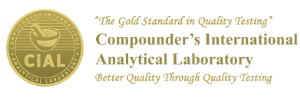
Pills and Solutions
Determining the absolute sterility of a product used for injections, infusions, the eyes, and when applicable, the nose cannot be done by a conventional sterility test. Some preparations contain ingredients, that by their nature, prevent microbial growth. For example, antibiotics given via injection are designed to prevent microbial growth, yet they still need to have the sterility verified.
A conventional sterility test cannot be relied upon to be completely accurate when the matrix is oily or other conditions that could mask the presence of microbes is present. The best course of action is to verify the sterility by performing a Sterility Suitability Validation, sometimes known as a Growth Promotion test, as outlined in the USP.
The test consists of inoculating a sample with six different microorganisms as dictated by USP <71>, and incubating them in a compatible media. They are then observed for promotion of growth. If growth is observed, then it is reasonable to assume that growth will also be observable in a sterility test. In other words, there is nothing present that can prevent the growth.
Preparations that contain potentially masking ingredients such as oils or antibiotics, must be treated in such a way that would eliminate any interference with the test. Once it is proven that microbes will grow if present in the sample, then a conventional sterility test can be conducted with the confidence that the results will be accurate. The two tests can be run in conjunction with each other to save time, but they must be run exactly the same way, using the same equipment, media, etc., with the exception of adding microbes to the validation test. Once a formulation has been proven to have a valid sterile method of testing, it is not necessary to repeat the test again, as long as nothing within the formulation or packaging changes.
There is a school of thought that says a “library” from different sources can be built and as long as the formulation is the same, any preparation can be assumed to be sterile and a growth promotion test is not necessary. CIAL believes that relying on an unknown entity to test a formulation “the same as” yours is risky. Human error can occur, and regulatory agencies may want to be assured the formulation was prepared according to the SOP and protocol specific to your facility. The one time extra test is well advised.
